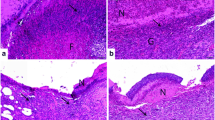Abstract
It is considered that the mechanism in intractable cutaneous ulcer is deeply associated with prolongation at the inflammatory phase. Having evaluated the effects of Lipo-prostaglandin E1 (Lipo-PGE1) with indicators such as the reduction ratio of the ulcer area and the values of the inflammatory markers after dividing them into two groups of collagen diseases and non-collagen diseases and giving them Lipo-PGE1, we managed to obtain the result that Lipo-PGE1 administration could influence various inflammatory markers such as C-reactive protein (CRP), IL-6, and VEGF in addition to reduction of the ulcer region. It also suggested that Lipo-PGE1 has the effect of maintaining an appropriate balance of induction of inflammation and angiogenesis. Additionally, it revealed that Lipo-PGE1 controls the production of cytokines, which are associated with the growth of collagen diseases. From these results, it can be expected that Lipo-PGE1 will act favorably on intractable collagen diseases.




Similar content being viewed by others
References
Yamaguchi Y, Yoshikawa K (2001) Cutaneous wound healing: an update. J Dermatol 28:521–534
Cianfarani F, Tommasi R, Failla CM, Viviano MT, Annessi G, Papi M, Zambruno G, Odorisio T (2006) Granulocyte/macrophage colony-stimulating factor treatment of human chronic ulcers promotes angiogenesis associated with de novo vascular endtherial growth factor transcription in the ulcer bed. Br J Dermatol 154:34–41
Lauer G, Sollberg S, Colo M, Flamme I, Sturzebecher J, Mann K, Krieg T, Eming SA (2000) Expression and proteolysis of vascular endtherial growth factor is increased in chronic wounds. J Invest Dermatol 115:12–18
Papps PJ, Fallek SR, Gracia A, Anaki CT, Back TL, Duran WK, Hobson RW 2nd (1995) Role of leukocyte activation in patients with venous stasis ulcers. J Surg Res 59:553–559
Frenkel O, Shani E, Ben-Bassat I, Brok-Simoni F, Rozenfeld-Granot G, Kajakaro G, Rechavi G, Amariglio N, Shinar E, Danon D (2002) Activated macrophages for treating skin ulceration:gene expression in human monocytes after hypo-osmotic shock. Clin Exp Immunol 128:59–66
Ganter U, Arcone R, Toniatti C, Morrone G, Ciliberto G (1989) Dual contorol of C-reactive protein gene expression by interleukin-1 and interleukin-6. EMBO J 8:3773–3779
Rothlein R, Mainolfi EA, Czajkowski M, Marlin SD (1991) A form of circulating ICAM-1 in human serum. J Immunol 147:3788–3793
Hahn J, Junger M, Friedrich B, Zuder D, Steins A, Hahn M, Klyscz T (1997) Cutaneous inflammation limited to the region of the ulcer in chronic venous insufficiency. Vasa 26:277–281
Rowe IF, Deans AC (1986) Serum C-reactive protein measurement in pyoderma gangreosom. Dermatologica 173:216–219
Heshmat NM, EL-Kerdanv TH (2007) Serum levels of vascular endothrial growth factor in children and adolescents with systemic lupus erythematosus. Pediatr Allergy Immunol 18:346–353
Kikuchi K, Kubo M, Kadono T, Yazawa N, Ihn H, Tamaki K (1998) Serum concentrations of vascular endothrial growth factor in collagen diseases. Br J Dermatol 139:1049–1051
Fava RA, Olsen NJ, Spencer-Green G, Yeo KT, Berse B, Jackman RW, Senger DR, Dvorak HF, Brown LF (1994) Vascular permeability factor/endothrial growth factor (VPF/VEGF) accumulation and expression in human synovial fluids and rheumatoid synovial tissue. J Exp Med 180:341–346
Murphy MA, Jovce WP, Condron C, Bouchier-Haves D (2002) A reduction in serum cytokine levels parallels healing of venous ulcers in patients undergoing compression therapy. Eur J Vasc Endovasc Surg 23:349–352
Drinkwater SL, Burnand KG, Ding R, Smith A (2003) Increased but ineffectual angiogenic drive in nonhealing venous leg ulcers. J Vasc Surg. 38:1106–1112
Aoki S, Imai K, Yachi A (1993) Soluble intercellular adhesion molecule-1 (ICAM-1) antigen in patients with rheumatoid arthritis. Scand J Immunol 38:485–490
Machold KP, Kiener HP, Graninger W, Graninger WB (1993) Soluble intercellular adhesion molecule-1(ICAM-1) in patients with rheumatoid arthritis and systemic lupus erthmatosus. Clin Immunol Immunopathol 68:74–78
Cush JJ, Rothlein R, Lindslev HB, Mainolfi EA, Lipskv PE (1993) Increased levels of circulating intercellular adhesion molecute 1 in the sera of patients with rheumatoid arthritis. Arthritis Rheum 36:1098–1102
Sfikakis PP, Tesar J, Baraf H, Lipnick R, Klipple G, Tsokos GO (1993) Circulating intercellular adhesion molecute-1 in patients with systemic sclerosis. Clin Immunol Immunopathol 68:88–92
Kiener H, Graninger W, Machold K, Aringer M, Graninger WB (1994) Increased levels of circulating intercellular adhesion molecule-1 in patients with systemic sclerosis. Clin Exp Rheumatol 12:483–487
Murota H, Muroi E, Yamaoka T, Hamasaki Y, Katayama I (2006) Successful treatment with regimen of intravenous gamma globulin and cyclophosphamide for dermatomyositis accompanied by interstitial pneumonia, opportunistic infection and steroid psychosis. Allergol Int 55:199–202
Mizushima Y, Yanagawa A, Hoshi A (1983) Prostaglandin E1 is more effective, when incorporated in lipid microspheres, for treatment of peripheral vascular diseases in man. J Pharm Pharmacol 35:666–667
Tsutsui K, Shirasaki F, Takata M, Takehara K (1996) Successful treatment of livedo vasculitis with beraprost sodium: a possible mechanism of thrombomodulin upregulation. Dermatology 192:120–124
Author information
Authors and Affiliations
Corresponding author
Rights and permissions
About this article
Cite this article
Murota, H., Kotobuki, Y., Umegaki, N. et al. New aspect of anti-inflammatory action of lipo-prostaglandinE1 in the management of collagen diseases-related skin ulcer. Rheumatol Int 28, 1127–1135 (2008). https://doi.org/10.1007/s00296-008-0589-5
Received:
Accepted:
Published:
Issue Date:
DOI: https://doi.org/10.1007/s00296-008-0589-5




